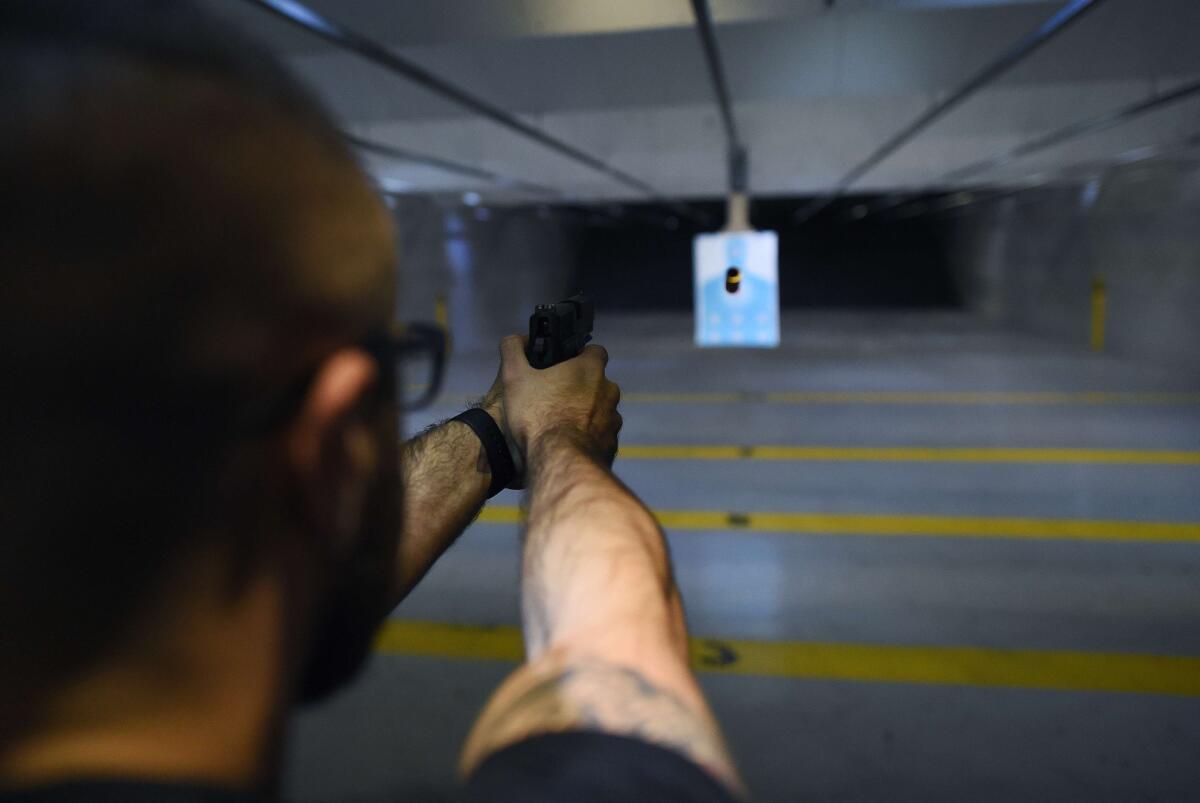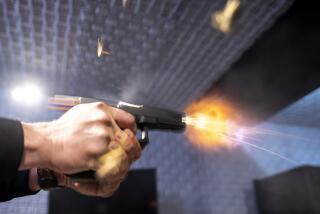Aiming to bring smart guns to U.S. market

One obstacle to gun owners’ acceptance of safety technology is its identification with anti-gun activism. Above, a man fires a handgun at a shooting range in New Jersey.
Tim Oh, 19, is an Anaheim-born and -raised engineering student with a promising idea: It’s a sturdy metal gun safe keyed to the owner’s fingerprint, so it can’t be opened by strangers or children. He also has a $10,000 grant from the San Francisco-based Smart Tech Challenges Foundation.
Jonathan Mossberg’s family has been manufacturing shotguns for generations. For 15 years, he’s been working on a shotgun that won’t fire unless it’s wielded by a shooter wearing a magnetic ring bearing an authentication code. Last year, Mossberg, 50, received a $100,000 grant from the foundation.
These grants represent two parallel trends. One is the revival of interest in electronic and biometric gun-safety technologies, which have languished for years because of disinterest, even hostility, from gun owners and manufacturers. The other is an emerging effort among Silicon Valley entrepreneurs to channel competitive instincts toward solving social problems.
Among the chief backers of the Smart Tech foundation is Ron Conway, a prominent San Francisco venture investor who happened to be hosting a Christmas party for former Rep. Gabby Giffords (D-Ariz.) the same day 20 children and six adults died in a shooting rampage at Sandy Hook Elementary School. “Ron realized that technology could play a role in addressing gun violence,” said Margot Hirsch, a former business associate of Conway’s who is now president of the Smart Tech foundation.
The eventual result was the Smart Tech challenge, a competition for research and development funding that drew 200 applications when it was launched in January 2014. The program resembles a hybrid of two Silicon Valley institutions: the X Prize, which offers multimillion-dollar awards for innovations addressing such goals as ending illiteracy or developing clean energy sources; and staged competitions like TechCrunch Disrupt, in which would-be entrepreneurs parade their ideas in the hope of attracting media attention and start-up capital.
The challenge judges eventually awarded 15 grants — five each of $10,000, $50,000 and $500,000, with the projects judged closest to marketability collecting the biggest sums and the others seed money. Oh, for instance, is hoping to augment his grant with an investment from a Silicon Valley accelerator specializing in transforming hardware prototypes into commercial products. The focus was on technologies for “personalizing” or “authorizing” technologies aimed chiefly at gun owners concerned about their weapons falling into children’s or strangers’ hands. The most common approaches involve biometric authentication via fingerprints or electronic unlocking through short-range radio frequency identification, or RFID, tokens.
Gun-safety technologies like these wouldn’t have prevented mass violence such as the Nov. 27 attack on a Planned Parenthood clinic in Colorado Springs or the Dec. 2 San Bernardino shooting attack. The goal instead is to reduce firearms injuries caused by unauthorized or unintended users, including suicide victims, especially youths, and children who encounter loaded guns in the home, and criminal suspects who get their hands on officers’ weapons.
The toll is significant. Of 33,636 deaths from firearms counted by the Centers for Disease Control and Prevention in 2013, some 62%, or 21,175, were suicides, and about 11% of those were of people ages 5 to 24. Accidental shootings accounted for 505 deaths, including 69 victims ranging in age from less than 1 year to 14 years.
“If guns were personalized, none of these would happen,” says Stephen Teret, a gun-policy expert at Johns Hopkins University who was one of the Smart Tech judges. Suicides, he observes, tend to be “means-specific” — if a gun isn’t at hand, many suicidal youths would abandon the effort. The roughly 200,000 stolen guns reported each year would be rendered effectively worthless if they were “smart” guns.
What these technologies have in common is that their market is a voluntary one. Only Massachusetts requires guns to be locked in storage, though the law applies to handguns and assault weapons only. A few other states, including California, require locks only under limited conditions.
Nor is the Smart Tech Foundation interested in moving beyond promoting technology to lobbying on legislation. Nor do many of its grantees appear interested in mandates for their technologies. “I’m interested in a free market,” Mossberg told me.
That may be understandable, because one obstacle to gun owners’ acceptance of safety technology is its identification with anti-gun activism. Manufacturer efforts to develop such technologies in the past have been quickly shot down. Gun shops such as the Oak Tree Gun Club in Newhall that were identified last year as distributors of the Armatix iP1, a German-made handgun that can be fired only by a user wearing an authenticating wristband, came under a withering backlash that led them to abandon the product.
One issue is a 2002 New Jersey law that requires firearms dealers to stock only smart guns within three years after such a product is sold anywhere in the U.S. Teret, the law’s drafter, says the idea was to counteract gun manufacturers’ claims that no market existed for smart-gun technology by “guaranteeing them a market in at least one state,” he told me. Instead, the law strengthened the gun lobby’s determination to prevent the introduction of any smart guns at all. New Jersey is now pondering a change that would mandate only that gun shops carry smart guns among their other inventory.
In the infancy of the technology, fears that smart guns would simply open the door to more gun control mixed with gun owners’ doubts about smart guns’ reliability. Smart-gun enthusiasts hope that familiarity with devices like smartphones has finally overcome those doubts. “This technology is no big deal to millennials,” Mossberg says, “so there’s a lot more interest in it today.”
Still, gun makers have been burned by pushback from gun owners and the National Rife Assn. before. Colt’s Manufacturing plunged deeply into smart-gun development in the 1990s, hoping to tap an unserved market and rescue itself from a prolonged slump.
By 1999, Colt’s had developed a prototype weapon that could be fired only by someone wearing a wristband emitting a coded radio signal. According to an internal memo unearthed during a lawsuit against the gun industry, the company had made “exceptional progress” on the technology — so much that it feared that competitors would spend heavily to “start catching up” if they realized the smart gun was viable. Colt’s hoped to obtain as much as $40 million from the Clinton administration to push the project along.
None of that happened. Facing a threatened boycott by NRA members, Colt’s abandoned the smart-gun project.
Interest in developing smart-gun technology waned. In 1996 the Sandia National Laboratory examined fingerprint, voice and electromagnetic unlocking systems and judged reliable systems to be years away; when the lab revisited the field in 2001, it found that “multiple years” of dedicated R&D would be needed before a smart gun could be perfected. The fact that a Silicon Valley foundation has to prime research and development with cash grants suggests they haven’t made much progress since then. It may take a fundamental shift in public acceptance, not just money, to get them to market at last.
Michael Hiltzik’s column appears every Sunday. His new book is “Big Science: Ernest Lawrence and the Invention That Launched the Military-Industrial Complex.” Read his blog every day at latimes.com/business/hiltzik, reach him at mhiltzik@latimes.com, check out facebook.com/hiltzik and follow @hiltzikm on Twitter.







